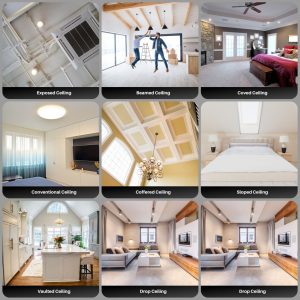
Ceiling types
The Role of Ceilings
A ceiling is more than the “fifth wall” of a room — it helps define space, impacts acoustics, and reflects a home’s architectural style. In Eastern Ontario, ceilings range from simple flat drywall in suburban builds to elaborate decorative designs in heritage homes. Materials and finishes are chosen based on cost, durability, and the desired aesthetic, all while working within the home’s structural framework.
Common Ceiling Types
1. Flat Ceilings
-
Description: The most common type, horizontal and smooth.
-
Eastern Ontario Use: Found in most modern homes and renovations. Clean, versatile, and easy to paint or finish.
2. Textured Ceilings (Popcorn, Stipple, Knockdown)
-
Description: Sprayed or hand-applied texture for concealment of imperfections.
-
Eastern Ontario Use: Very common in mid-20th-century homes (1950s–1990s). Modern trends favour smooth finishes, though knockdown textures remain in some builds.
3. Coffered Ceilings
-
Description: A grid of recessed panels, often square or rectangular, framed with beams or mouldings.
-
Eastern Ontario Use: Found in upscale custom homes, dining rooms, or great rooms — adds elegance and depth.
4. Tray Ceilings
-
Description: A raised center section bordered by a dropped edge, creating a “tray” effect.
-
Eastern Ontario Use: Popular in master bedrooms and dining rooms for architectural interest.
5. Vaulted and Cathedral Ceilings
-
Description: Angled ceilings that rise to the roofline. Cathedral ceilings mirror the roof slope; vaulted ceilings are higher but not parallel.
-
Eastern Ontario Use: Common in cottages, custom builds, and open-concept living areas, adding light and spaciousness.
6. Exposed Beam or Open Joist Ceilings
-
Description: Exposed wood or structural elements.
-
Eastern Ontario Use: Seen in historic farmhouses, barns, and modern rustic cottages. Adds charm and warmth.
7. Suspended (Drop) Ceilings
-
Description: Panels hung in a metal grid below the structural ceiling.
-
Eastern Ontario Use: Common in basements, providing easy access to plumbing and wiring.
8. Decorative Ceilings (Tin, Wood, Plasterwork)
-
Description: Stamped tin tiles, ornate plaster medallions, or tongue-and-groove wood.
-
Eastern Ontario Use: Tin ceilings are common in heritage homes and commercial buildings; wood plank ceilings appear in cottages and rustic designs.
Ceiling Materials
-
Drywall (Gypsum Board): Standard material for most ceilings; can be smooth or textured.
-
Plaster: Traditional material in older homes (pre-1950s). Durable but labour-intensive to repair.
-
Wood: Used in planks, panels, or beams; adds warmth and character. Cedar and pine are common in cottages.
-
Metal (Tin or Aluminum Tiles): Durable, reflective, and decorative; popular in historic or industrial-style spaces.
-
PVC or Vinyl Panels: Low-maintenance option, often used in basements or utility rooms.
-
Acoustic Tiles: Found in suspended ceilings; designed to absorb sound and provide easy access to utilities.
-
Glass or Acrylic Panels: Less common, but sometimes used in modern designs or commercial applications.
Climate and Regional Considerations
In Eastern Ontario, ceilings must also account for insulation and moisture control. Basements often use drop ceilings to allow access to plumbing and prevent moisture issues. In older homes, plaster ceilings may require reinforcement due to cracking. For energy efficiency, cathedral ceilings must be carefully insulated and ventilated to avoid ice dams on the roof.
👉 In summary, ceilings in Eastern Ontario range from simple drywall flats to ornate tin, coffered, and vaulted designs. Materials vary from gypsum and plaster to wood, metal, and acoustic panels, each chosen for a balance of cost, durability, and aesthetic impact.

